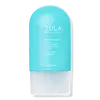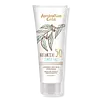Tula Skincare Mineral Sunscreen Fluid Broad Spectrum SPF 30 Versus Australian Gold Botanical SPF 50 Tinted Face
What's inside
What's inside
 Key Ingredients
Key Ingredients

 Benefits
Benefits

 Concerns
Concerns

 Ingredients Side-by-side
Ingredients Side-by-side

Titanium Dioxide 3.6%
Cosmetic ColorantZinc Oxide 2.34%
Cosmetic ColorantWater
Skin ConditioningIsododecane
EmollientC12-15 Alkyl Benzoate
AntimicrobialDimethicone
EmollientTriethylhexanoin
MaskingCaprylic/Capric Triglyceride
MaskingButyloctyl Salicylate
Skin ConditioningCaprylyl Methicone
Skin ConditioningSilica
AbrasiveStyrene/Acrylates Copolymer
Pentylene Glycol
Skin ConditioningTriolein
Skin ConditioningMagnesium Sulfate
Lactobacillus
Skin ConditioningLactobacillus Ferment
Skin ConditioningLactococcus Ferment Lysate
Skin ConditioningBeta Vulgaris Root Extract
Skin ConditioningCurcuma Longa Root Extract
MaskingPrunus Persica Fruit Extract
AbrasivePrunus Persica Leaf Extract
EmollientEpilobium Angustifolium Flower/Leaf/Stem Extract
Skin ConditioningHedychium Coronarium Root Extract
MaskingInulin
Skin ConditioningLactic Acid
BufferingPolymnia Sonchifolia Root Juice
Skin ConditioningAlpha-Glucan Oligosaccharide
CleansingLithothamnion Calcareum Powder
AbrasiveOcimum Sanctum Leaf Extract
Skin ConditioningZinc Sulfate
AntimicrobialAloe Barbadensis Flower Extract
EmollientAminopropyl Triethoxysilane
Butylene Glycol
HumectantCoccinia Indica Fruit Extract
Skin ConditioningCocos Nucifera Fruit Extract
EmollientTocopherol
AntioxidantCorallina Officinalis Extract
Skin ConditioningDiatomaceous Earth
AbrasivePolyglyceryl-3 Polyricinoleate
EmulsifyingDimethicone/PEG-10/15 Crosspolymer
Dipropylene Glycol
HumectantGlycerin
HumectantDisteardimonium Hectorite
StabilisingIsopropyl Titanium Triisostearate
EmollientIsostearic Acid
CleansingSolanum Melongena Fruit Extract
Skin ConditioningMaltodextrin
AbsorbentMannitol
HumectantMelia Azadirachta Flower Extract
Skin ConditioningMelia Azadirachta Leaf Extract
Skin ConditioningMica
Cosmetic ColorantNylon-12
PEG-9 Polydimethylsiloxyethyl Dimethicone
EmulsifyingPhenyl Trimethicone
Skin ConditioningPolyhydroxystearic Acid
EmulsifyingPropanediol
SolventPropylene Carbonate
SolventRubus Idaeus Fruit Extract
AstringentPyrus Malus Fruit Extract
Skin ConditioningSodium Benzoate
MaskingPrunus Armeniaca Kernel Extract
Skin ConditioningSodium Citrate
BufferingSodium Metabisulfite
AntioxidantStearic Acid
CleansingEthylhexylglycerin
Skin ConditioningPhenoxyethanol
PreservativeSodium Chloride
MaskingAmmonium Hydroxide
BufferingTrisodium Ethylenediamine Disuccinate
1,2-Hexanediol
Skin ConditioningCaprylyl Glycol
EmollientCI 77891
Cosmetic ColorantCI 77491
Cosmetic ColorantTitanium Dioxide 3.6%, Zinc Oxide 2.34%, Water, Isododecane, C12-15 Alkyl Benzoate, Dimethicone, Triethylhexanoin, Caprylic/Capric Triglyceride, Butyloctyl Salicylate, Caprylyl Methicone, Silica, Styrene/Acrylates Copolymer, Pentylene Glycol, Triolein, Magnesium Sulfate, Lactobacillus, Lactobacillus Ferment, Lactococcus Ferment Lysate, Beta Vulgaris Root Extract, Curcuma Longa Root Extract, Prunus Persica Fruit Extract, Prunus Persica Leaf Extract, Epilobium Angustifolium Flower/Leaf/Stem Extract, Hedychium Coronarium Root Extract, Inulin, Lactic Acid, Polymnia Sonchifolia Root Juice, Alpha-Glucan Oligosaccharide, Lithothamnion Calcareum Powder, Ocimum Sanctum Leaf Extract, Zinc Sulfate, Aloe Barbadensis Flower Extract, Aminopropyl Triethoxysilane, Butylene Glycol, Coccinia Indica Fruit Extract, Cocos Nucifera Fruit Extract, Tocopherol, Corallina Officinalis Extract, Diatomaceous Earth, Polyglyceryl-3 Polyricinoleate, Dimethicone/PEG-10/15 Crosspolymer, Dipropylene Glycol, Glycerin, Disteardimonium Hectorite, Isopropyl Titanium Triisostearate, Isostearic Acid, Solanum Melongena Fruit Extract, Maltodextrin, Mannitol, Melia Azadirachta Flower Extract, Melia Azadirachta Leaf Extract, Mica, Nylon-12, PEG-9 Polydimethylsiloxyethyl Dimethicone, Phenyl Trimethicone, Polyhydroxystearic Acid, Propanediol, Propylene Carbonate, Rubus Idaeus Fruit Extract, Pyrus Malus Fruit Extract, Sodium Benzoate, Prunus Armeniaca Kernel Extract, Sodium Citrate, Sodium Metabisulfite, Stearic Acid, Ethylhexylglycerin, Phenoxyethanol, Sodium Chloride, Ammonium Hydroxide, Trisodium Ethylenediamine Disuccinate, 1,2-Hexanediol, Caprylyl Glycol, CI 77891, CI 77491
Titanium Dioxide 4%
Cosmetic ColorantZinc Oxide 4%
Cosmetic ColorantAlumina
AbrasiveButyrospermum Parkii Butter
Skin ConditioningCaprylyl Glycol
EmollientCetyl PEG/PPG-10/1 Dimethicone
EmulsifyingCyclopentasiloxane
EmollientDimethicone Crosspolymer
Emulsion StabilisingDisodium EDTA
Disteardimonium Hectorite
StabilisingEucalyptus Globulus Leaf Extract
PerfumingGlycerin
HumectantHexyl Laurate
EmollientIron Oxides
Panthenol
Skin ConditioningPEG-10 Dimethicone
Skin ConditioningPhenoxyethanol
PreservativePolyglyceryl-4 Isostearate
EmulsifyingPolymethylsilsesquioxane
Porphyra Umbilicalis Extract
Skin ConditioningSilica
AbrasiveSqualane
EmollientStearic Acid
CleansingTocopheryl Acetate
AntioxidantTriethoxycaprylylsilane
Water
Skin ConditioningTitanium Dioxide 4%, Zinc Oxide 4%, Alumina, Butyrospermum Parkii Butter, Caprylyl Glycol, Cetyl PEG/PPG-10/1 Dimethicone, Cyclopentasiloxane, Dimethicone Crosspolymer, Disodium EDTA, Disteardimonium Hectorite, Eucalyptus Globulus Leaf Extract, Glycerin, Hexyl Laurate, Iron Oxides, Panthenol, PEG-10 Dimethicone, Phenoxyethanol, Polyglyceryl-4 Isostearate, Polymethylsilsesquioxane, Porphyra Umbilicalis Extract, Silica, Squalane, Stearic Acid, Tocopheryl Acetate, Triethoxycaprylylsilane, Water
 Reviews
Reviews

Ingredients Explained
These ingredients are found in both products.
Ingredients higher up in an ingredient list are typically present in a larger amount.
Caprylyl Glycol is a humectant and emollient, meaning it attracts and preserves moisture.
It is a common ingredient in many products, especially those designed to hydrate skin. The primary benefits are retaining moisture, skin softening, and promoting a healthy skin barrier.
Though Caprylyl Glycol is an alcohol derived from fatty acids, it is not the kind that can dry out skin.
This ingredient is also used as a preservative to extend the life of products. It has slight antimicrobial properties.
Learn more about Caprylyl GlycolDisteardimonium Hectorite comes from the clay mineral named hectorite. It is used to add thickness to a product.
It can also help stabilize a product by helping to disperse other ingredients.
Hectorite is a rare, white clay mineral.
Learn more about Disteardimonium HectoriteGlycerin is already naturally found in your skin. It helps moisturize and protect your skin.
A study from 2016 found glycerin to be more effective as a humectant than AHAs and hyaluronic acid.
As a humectant, it helps the skin stay hydrated by pulling moisture to your skin. The low molecular weight of glycerin allows it to pull moisture into the deeper layers of your skin.
Hydrated skin improves your skin barrier; Your skin barrier helps protect against irritants and bacteria.
Glycerin has also been found to have antimicrobial and antiviral properties. Due to these properties, glycerin is often used in wound and burn treatments.
In cosmetics, glycerin is usually derived from plants such as soybean or palm. However, it can also be sourced from animals, such as tallow or animal fat.
This ingredient is organic, colorless, odorless, and non-toxic.
Glycerin is the name for this ingredient in American English. British English uses Glycerol/Glycerine.
Learn more about GlycerinPhenoxyethanol is a preservative that has germicide, antimicrobial, and aromatic properties. Studies show that phenoxyethanol can prevent microbial growth. By itself, it has a scent that is similar to that of a rose.
It's often used in formulations along with Caprylyl Glycol to preserve the shelf life of products.
Silica, also known as silicon dioxide, is a naturally occurring mineral. It is used as a fine, spherical, and porous powder in cosmetics.
Though it has exfoliant properties, the function of silica varies depending on the product.
The unique structure of silica enhances the spreadability and adds smoothness, making it a great texture enhancer.
It is also used as an active carrier, emulsifier, and mattifier due to its ability to absorb excess oil.
In some products, tiny microneedles called spicules are made from silica or hydrolyzed sponge. When you rub them in, they lightly polish away dead skin layers and enhance the penetration of active ingredients.
Learn more about SilicaStearic Acid is a fatty acid. It is an emollient, emulsifier, and texture enhancer.
As an emollient, stearic acid helps soften skin. It aids the skin's protective barrier by preventing water loss. It also provides a gentle cleansing effect without stripping away natural oils.
Stearic acid may also be used to enhance the texture of products. It can add volume and stabilize ingredients such as water and oil. This can help water and oil ingredients from separating.
Sources of stearic acid include animal or vegetable fats/oils such as coconut or shea. It can be naturally found in butter, cocoa butter, shea butter, vegetable fats, and animal tallow.
This ingredient may not be Malassezia folliculitis, or fungal-acne safe.
Learn more about Stearic AcidTitanium dioxide is a mineral UV filter widely used in sunscreens and cosmetics.
It is one of only two UV filters officially classified as “mineral” by regulatory agencies, the other being zinc oxide.
Titanium dioxide provides broad-spectrum protection mostly in the UVB and UVAII range, with some protection in the UVAI range.
While its UVA protection isn’t as strong as zinc oxide’s, the difference is minor.
A common myth is that mineral UV filters reflect UV light. However, modern research shows titanium dioxide absorbs UV radiation like chemical filters (~95% absorption & 5% reflection).
Thanks to its non-irritating nature, titanium dioxide is suitable for sensitive, acne-prone, or redness-prone skin. It is unlikely to cause "eye sting" like other sunscreen ingredients.
A major drawback of this ingredient is its white cast and thick texture. This is why mineral sunscreens often leave a white cast and are less cosmetically elegant than chemical/hybrid sunscreens.
To improve white cast and spreadability, micronized or nano-sized titanium dioxide is often used.
There are ongoing concerns surrounding nano-titanium oxide's impact on marine ecosystems.
There is no conclusive evidence that any form of titanium oxide (or any other sunscreen ingredients) will cause harm to marine ecosystems or coral reefs. The science is still developing but many consumers are keeping a close eye on this issue.
Please note, many destinations have reef-safety sunscreen rules. For instance, the U.S. Virgin Islands advises all visitors to use non-nano mineral sunscreens.
Nano mineral sunscreens once raised safety concerns about absorption into skin.
Extensive research has shown that they do not penetrate healthy or damaged skin; they remain safely on the surface and the top layer of dead skin (stratum corneum).
You'll likely find titanium dioxide bundled with alumina, silica, or dimethicone. These ingredients help make titanium dioxide highly photostable; this prevents it from interacting with other formula components under UV light.
Learn more about Titanium DioxideWater. It's the most common cosmetic ingredient of all. You'll usually see it at the top of ingredient lists, meaning that it makes up the largest part of the product.
So why is it so popular? Water most often acts as a solvent - this means that it helps dissolve other ingredients into the formulation.
You'll also recognize water as that liquid we all need to stay alive. If you see this, drink a glass of water. Stay hydrated!
Learn more about WaterZinc Oxide is a mineral broad-spectrum UV filter; it is the broadest UVA and UVB reflector approved by the FDA. It also has skin protectant and skin soothing properties.
Zinc oxide is one of the most effective broad-spectrum UV filters. It protects against UVB, UVAII, and UVAI. In comparison to its counterpart titanium dioxide, zinc oxide provides uniform and extended UVA protection.
Another great benefit? This ingredient is highly photostable so it won't degrade easily under sunlight.
A common myth is that mineral UV filters are widely believed to primarily reflect UV light.
However, modern research shows titanium dioxide absorbs UV radiation like chemical filters (~95% absorption & 5% reflection).
Zinc oxide has great skin soothing properties so you'll likely find this in sunscreens formulated for sensitive skin or babies/children. It is unlikely to cause "eye sting" like other sunscreen ingredients.
Regulatory agencies consider zinc oxide to be non-toxic and safe. It has also been shown to not penetrate the skin.
Unfortunately, this ingredient does leave a visible white cast. This is why mineral sunscreens are often less cosmetically elegant than chemical or hybrid ones.
In cosmetics, zinc oxide can be found in both non-nano and nano-sized forms. The nano version is used to reduce white cast and improve the texture of sunscreen formulas.
There are ongoing concerns surrounding nano-zinc oxide's impact on marine ecosystems and whether it can be absorbed into skin.
Regarding marine ecosystems and coral reefs, there is no conclusive evidence that any form of zinc oxide (or any other sunscreen ingredients) will cause harm. The science is still developing but many consumers are keeping a close eye on this issue.
Please note, many destinations have reef-safety sunscreen rules. For instance, the U.S. Virgin Islands advises all visitors to use non-nano mineral sunscreens.
There has also been some stir about whether micronized or nano zinc oxide has potential photoxicity and absorption through the skin/lungs.
An in-vitro (done in a test tube or petri dish) study demonstrated micronized zinc oxide to have potential phototoxicity. There's no need to fret; the EU Commission's Scientific Committee on Consumer Safety has stated, "The relevance of these findings needs to be clarified by appropriate investigations in vivo." Or in other words, further studies done on living organisms are needed to prove this.
Current research shows zinc oxide nanoparticles do not penetrate intact or sunburned skin. They either remain on the surface or in the outermost layer of dead skin (stratum corneum).
Zinc oxide is one of only two classified mineral UV filters with titanium dioxide being the other one.
Fun fact: Zinc has been used throughout history as an ingredient in paint and medicine. An Indian text from 500BC is believed to list zinc oxide as a salve for open wound. The Ancient Greek physician Dioscorides has also mentioned the use of zinc as an ointment in 1AD.
Learn more about Zinc Oxide